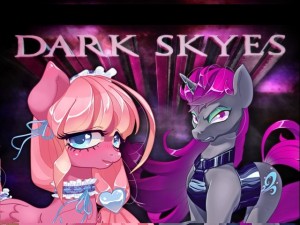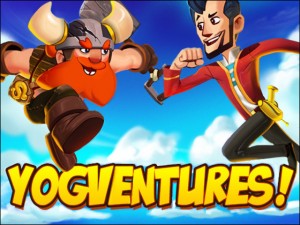As much as I love Kickstarter, and crowdfunding in general, I have to admit that it can be pretty scary at times. Scams, incompetence, emotional breakdowns, and general sketchiness seem to be just as common as starry eyed developers full of dreams. Given that we typically cover the starry eyed angle here on Cliqist I figured that for Halloween it was time to change things up a bit. I give you… (queue spooky music) 5 Terrifying Kickstarter Games.
 Dark Skyes
Dark Skyes
Might as well start with a crowd favorite! Dark Skyes, as longtime readers already know, was purported to be a Brony themed visual novel. For some people the idea of a game where you seduce and fornicate with a variety of My Little Pony inspired characters is terrifying in its own right, but I’m not here to judge. If you have an overpowering desire to get to know ponies on a deeper level then that’s your business. If you want to go behind some virtual dumpsters and have your own private Donkey Show with a Twilight Sparkle knock-off, by all means, do it. There’s an entire internet’s worth of far more disturbing fetishes.
What makes Dark Skyes so terrifying isn’t the sparkly pony bits, but what the campaign itself proved. As we’ve discussed in painfully extensive detail, Dark Skyes was the creation of a troll superstar Sam Hyde. Sam’s plan was to take (some of?) the money raised from the Kickstarter campaign and create a game overflowing with sexual depravity. The scary part is that it almost worked. At one point Sam’s project was trending to double its $7,500 funding goal.
Big deal, right? There’ve been plenty of other project creators that took off with far more money. The difference is that those were either scams or incompetence, so backers would have some recourse once things went south; at least in theory. I don’t doubt that Dark Skyes would have been made at some point; the entire point was to give My Little Pony fans a shock to the system and for Sam to record a YouTube video of him laughing at them. There would be a product though, which means that those backers’ virgin eyes wouldn’t have a leg to stand on if they tried getting their money back.
The idea of a Kickstarter campaign purely as a form of trolling isn’t something I’ve seen outside of Dark Skyes, which is surprising. Backers should expect more of them in the future, and that’s pretty scary if you ask me.
 Yogventures!
Yogventures!
Yogventures! isn’t something we’ve talked about on Cliqist before, which is strange since it’s one of the highest grossing Kickstarter video game projects of all time. This open world sandbox adventure game was a huge part of the mid 2012 Kickstarter explosion, bringing in an insane $567,665, which is particularly impressive when you consider that the funding video was just two of the guys putting the game together screwing around in a mock-up. But hey, people love their YouTubes, so why not give thousands of dollars to people that make funny sounds into a mic? Rather than, you know, developers with a proven track record.
You already know what happened with this one. Yogventures! is dead. The money is gone, with nothing more than a half-assed explanation as to where it went. Don’t worry though! Backers of the project were offered a cancellation prize in the form of a game they didn’t necessarily want, and that’s on the short walk to its own demise.
Terrifying is nearly 14,000 people giving half a million dollars to a couple guys to farm out a games development to a team that’s never made a game. The fact that 10 backers represent $75,000 in donations is something else entirely.
 CLANG
CLANG
A nightmare that’s eerily similar to Yogventures! in a number of uncomfortable ways, CLANG was the brainchild of famed sci-fi author Neal Stephenson. You’ll recognize him as that guy who wrote that book you used to get your AOL screen name from back in the day. In July of 2012 Neal and a bunch of his renaissance fair buddies got together to ask unsuspecting backers for $500,000 to not make a game. They even convinced Gabe Newell to tease people with Half-Life 3 in the funding video. Shockingly enough, they got the money, and then some.
These days Neal likes to coyly say that they never promised anyone an actual game. That’s partially true. The point of the CLANG campaign was to fund the development of software to allow for more realistic sword fighting in games; oh, and a “…PC arena game based on one-on-one multiplayer dueling.” The arena game was described by Neal as being a relatively simple and achievable goal. Yeah, about that.
Fast forward a couple years and the money is gone, CLANG is dead, and the only thing we’re left with is a punch line for overblown Kickstarter excess.
The Yogventures! failure was disappointing, but hardly surprising in hindsight; CLANG is different though. Not only was there was a big name tied to it, the objectives appeared to be attainable and realistic. The lesson? If you’re in the video game category on Kickstarter, keep an eye out for actual video games, not technological pet projects from snark sci-fi authors.
 Xeko
Xeko
Of all the Kickstarter campaigns with drama, Xeko is one of the most frustrating, convoluted, and mysterious.
In July of 2012, a time you’ll recognize once again as being the so-called ‘golden age‘ of Kickstarter, a campaign was launched to bring back the beloved Xeko collectable card game. The original version of Xeko was a physical game with cards that featured endangered animals and the like. While it wasn’t for everyone, Xeko certainly had a following, and they joined together to raise 250k to help bring Xeko back from the dead and into the video game world. On the surface everything looked great, with kindly faces on the funding video, video game godfather Nolan Bushnell attached, and constant communication from the developers.
The Xeko campaign ended on July 21st 2012, two weeks later the developers posted an update to give backers a heads up about reward surveys coming soon. Not a peep was heard from them until the end of March 2013. While many developers have a the unfortunate habit of ignoring backers as soon as they get their money, this was particularly unusual given the whole family vibe of the campaign. A couple months later a pair of updates went out promising that backers would be getting their rewards soon, but they offered no information about the game itself.
After several months of backers investigating and theorizing the developers finally posted a couple comments in December of 2013, and it was all bad. Long story short, they no longer had the rights to the Xeko brand and were out of money; but they were kind enough to point out that anyone is more than welcome to jump in and purchase the rights if they want. What about the backers? According to the developers it was friends and family that footed most of the bill, and that the rest of the backers didn’t have much of an impact; so screw ’em (I may be paraphrasing there).
The sickening lesson with Xeko is that no matter how badly you want a campaign to succeed, it doesn’t pay to avoid asking tough questions. While some will criticize people like Ahmad Khan for picking fights with certain campaigns, if everything is on the up and up then those answers should be fairly straight forward. Wishing, and hoping, that developers are doing the right thing simply because they have a great looking campaign and seem like nice people isn’t enough.
 Star Citizen
Star Citizen
How on Earth could Star Citizen be considered a nightmare? Chris Roberts and Co. raised a ton of money on Kickstarter, and continue to raise more at a blistering rate. In fact, as of this writing people have donated $59.3million. That’s nearly sixty million bucks. Let me put that into perspective for you.
- $4 million – Cost to develop Wing Commander 3
- $10 million – Cost to develop Wing Commander 4
- $30 million – production cost of the Wing Commander movie, which was directed by Chris Roberts.
- $50 million – Production cost of Lord of War, which was produced in part by Chris Roberts
There’s little doubt that Star Citizen will end up raising over $90 million before it’s eventual release, which is more than all of the above projects combined.
This is scary for two reasons, and neither one of them is fear of a scam or developer implosion. Instead, it’s all about hype and expectations. Hype because Chris Roberts has a long illustrious history of not only making great games, but telling people how great they’re going to be. You couldn’t open a game magazine in the 90’s without there being a story about how awesome the latest Chris Roberts game was going to be; unfortunately that same story would also discuss the lengthy delays to said game. Roberts is a guy with big ideas, which is fantastic, but even his best games have fallen short of their lofty selling points. This brings us to the most difficult part: expectations. Although a ton of money has been raised, it still pales in comparison to what it takes to create a AAA game these days. When Star Citizen comes out I’m sure it’ll be a great game, it might even be fantastic, but at this point everyone is expecting their have their lives changed by it. I’m terrified to see what people’s reactions will be when it doesn’t live up to their impossibly high expectations.
Remember everyone. As fantastic as Kickstarter and crowdfunding in general is, you’ve gotta be skeptical, cautious, and frugal. It’s not always as simple as spotting an obvious scam, sometimes it’s just about being prepared for the worst.






I agree that its best not to judge anyone but when I saw Dark Skyes on Kickstarter I knew this would be the Bronies worst nightmare or wet dream LOL!
[…] everything will be all right. And why wouldn’t it be, it’s not like anyone has ever failed to deliver on their Kickstarter […]
[…] No. 9 or Godus, and its own mini-scandal with JonTron doesn’t rank anywhere near that of the cancellation of Yogventures. But in line it is, and hosting another highly-funded game there could be the last […]